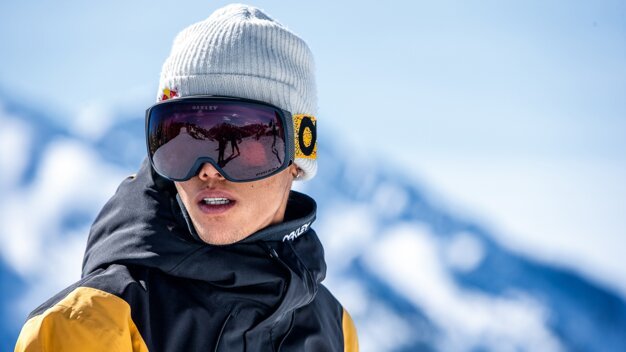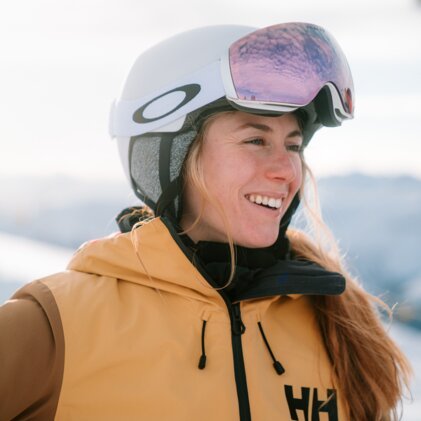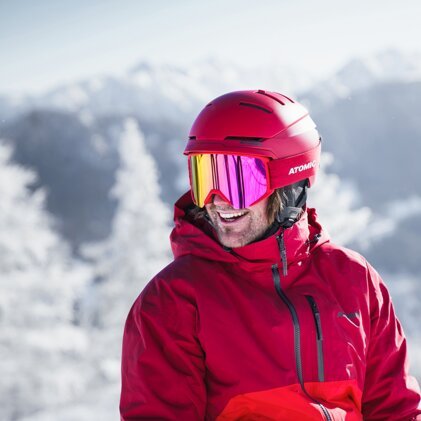
It's a match! With ski goggles that fit you really well, you're ready for any adventure on the slopes. The catch: To find a perfect sized goggle isn't that easy. Unlike sunglasses, ski goggles for winter sports enthusiasts have additional requirements.
Similar to skis and ski boots, finding the right size of ski goggles is crucial. But do you know what measurements and aspects to consider when buying? Or which model fits which helmet? In our guide, you will learn everything you need to know about ski goggles – and get tips on how to find your perfect match with INTERSPORT Rent and Oakley!
What size ski goggles do I need?
Every face is different. That's why choosing the perfect ski goggle is such a personal matter. The size and shape of the ski goggle is just as important as the padding, ventilation and strap.
Ski goggles are usually available in sizes S, M and L. Small models are best suited for children and teenagers or people with small heads and narrow facial features. Medium models are normally for winter sports enthusiasts aged 12 and above, as well as women and men with narrow faces. Large ski goggles are designed for people with average to large heads. There are also goggles with an "Asian fit" for winter sports enthusiasts with high cheekbones and a rather flat nose bridge.
To get a rough idea of what size you need, you should measure your face before buying a ski goggle. You can determine the size with a simple tape measure:
- Width of the face (between the temples)
- Depth of your face (from the centre of your cheekbones to just above your eyebrows)
These figures will help you determine whether you should try on goggles in size S, M or L. Once you have found a pair of goggles that you like, you should compare your measurements with the corresponding results in the manufacturer's specifications.
Tip: With Oakley ski goggles, the size is always part of the product name, for example: Flight Deck™ L or Target Line M.
The differences between cylindrical and spherical lenses
When choosing the right ski goggles, the shape of the lenses plays an important role in ensuring adequate eye protection. A basic distinction is made between cylindrical and spherical models – both options offer different advantages in terms of fit, field of vision and optical perception.
Cylindrical lenses:
- Are curved on the horizontal axis but flat on the vertical axis.
- They have a straight front, which is particularly popular in modern, frameless models.
- Their design ensures a slim, stylish look and often a more compact fit.
- The flatter, vertical shape can cause optical distortion at certain angles and may slightly restrict the field of vision, especially upwards and downwards.
Spherical lenses:
- These are curved both horizontally and vertically, mimicking the natural curvature of the human eye.
- The double curvature provides a particularly wide and natural-looking field of vision, enabling an accurate perception of the surroundings.
- The light is distributed more evenly across the surface, reducing glare and improving depth perception.
- Spherical lenses often sit slightly further away from the face, making them appear larger. Conversely, this provides better ventilation and reduces the risk of fogging up ski goggles.
Cylindrical lenses score points with their modern look and snug fit, while spherical models impress with their expanded field of view and optical quality. Which option is better ultimately depends on personal priorities – whether design and compact fit or maximum vision and detailed representation are the main focus.
OTG ski goggles for spectacle wearers
Although spherical ski goggles are a great accessory, the space inside them is so limited that there is no room for optical glasses underneath. What solutions are available for winter sports enthusiasts who rely on visual aids? OTG (Over the Glasses) ski goggles are specially designed for spectacle wearers and offer a comfortable solution for wearing corrective glasses under ski goggles. In contrast to the other types mentioned, they have a slightly larger interior volume and recesses in the foam at temple level for the spectacle arms. This design ensures a comfortable fit and prevents pressure points or slipping. Modern OTG models guarantee the same comfort, protection and style as cylindrical or spherical ones. Winter sports enthusiasts who wear glasses don't have to compromise on their field of vision either: the generous frame shape guarantees clear view.
Which ski goggles go with which helmet?
Just as your skis and bindings form a unit with your ski boots, your goggle and ski helmet must also be compatible. There are several reasons for this:
- Poorly fitting ski goggles or helmets can cause pressure points and reduce comfort.
- Goggles that don't fit properly impair vision and thus affect comfort and safety.
- The ventilation systems of the ski goggles and helmet must be compatible. Otherwise, the inside of the goggles may fog up because the warm air is not effectively circulated.
- Ski goggles are more than just a fashionable replacement for sunglasses. The frame and lenses complement the protective effect of the ski helmet and guarantee resistance to UV radiation and difficult visibility conditions.
If you are unsure about which ski goggle to choose, ask an expert for their opinion. For example, take your ski helmet to one of our INTERSPORT Rent shops and try out the different sizes and fits to see how they feel.
Tip: Bring your hat and, if necessary, your mask or neck warmer with you. If our RENTertainers know how you normally ski, they can help you best.
The right fit for your ski goggles – without any "goggle gap"
Perhaps you've heard the term "goggle gap" or "gaper gap" before? This refers to the distance between the front lower edge of your ski helmet and the upper edge of your ski goggle frame. This is a typical phenomenon that occurs when your ski helmet and goggles don't fit together properly. A "gaper or goggle gap" not only looks strange, but can also have consequences. Because your forehead is exposed, there is a risk of frostbite and sunburn. In addition, your goggles may fog up because the warm, moist air cannot escape.
Clear vision thanks to the Modular Brim System
Oakley's Modular Brim System ensures perfect interaction between goggles and ski helmet. At Oakley, the brim refers to the front lower edge of the ski helmet. This area is interchangeable on helmet models featuring this technology. This has the following advantages:
- You can adjust your helmet to be compatible with the fit and size of your ski goggles.
- You have flexibility in terms of ventilation.
Oakley ski helmets also feature special brim ventilation. This allows warm air to escape and prevents your goggles from fogging up. The goggle clip on the back of the helmet provides additional support. All we can say is: It's a match!
How do I know if my ski goggles really fit?
It's easy to find out if your goggles fit perfectly. Consider the following aspects:
- Your ski goggles must feel comfortable.
- It should also fit snugly against your cheekbones, the bridge of your nose and your forehead, adapting to the shape of your face.
- Also, make sure that the elastic band does not squeeze the foam of the frame too much. This not only leaves pressure marks, but also leads to poor air circulation.
Something still not quite right? We have compiled a list of the most common problems that our RENTertainers encounter time and time again. They have shared a few simple tricks with us:
If your ski goggle...
- ...presses around the eye sockets: This means that the goggles are too narrow for your face. Try a model with a wider frame instead!
- ... presses against your nose: Tighten the strap and try to push the ski goggles up a little higher. Otherwise, try a model that is smaller or has a different shape around the nose!
- ... does not sit flush on your nose: Loosen the strap and push the goggles down a little further. If that doesn't help, try a model with a wider bridge!
- ... presses against your temples: Loosen the strap or try a wider model!
Tip: A good trick is to first hold the ski goggles against your face without pulling the elastic band behind your head. This will give you a better feel for how well the frame fits your facial features. The pressure of the foam should be even at all contact points. If this is not the case, try a different frame shape.
Frequently asked questions about the ski goggle size
How can I tell if my ski goggles are too big?
You will notice this when there are noticeable gaps between the contact points on your cheekbones, bridge of your nose and forehead. This allows air or snow to get in and impairs your vision. Another indication that your ski goggles are too large is if they constantly slip down your face because the frame rests below your cheekbones. When you move, they gradually slide down.
How do you measure the size of ski goggles?
The size of the goggles themselves can be found in the manufacturer's specifications. Both the width and depth of your face are crucial for the right fit. Measure both the distance between your temples and the distance between the centre of your cheekbones and just above your eyebrows.
How can you tell if ski goggles are too small?
A quick way to tell if your goggles are too small is to look at the "gaper gap. This is the distance between the top edge of the goggles and the front, lower edge of the helmet. If your forehead is clearly visible underneath, this is an indication that the goggles are too small. However, even if the field of vision feels too small, this may be an indication that the frame should be larger.
INTERSPORT Rent tip
The RENTertainer recommends
Haven't found your "perfect match" yet? No need to worry! The RENTertainers in our shops are true ski goggle experts and know exactly how to find the perfect goggle for your face shape.
Just pop into one of our more than 800 shops in Europe and Canada and browse our huge range! Don't forget your helmet, hat and scarf or mask – these items of your kit will help us find the perfect product for you.
Related articles
You may also be interested in:




